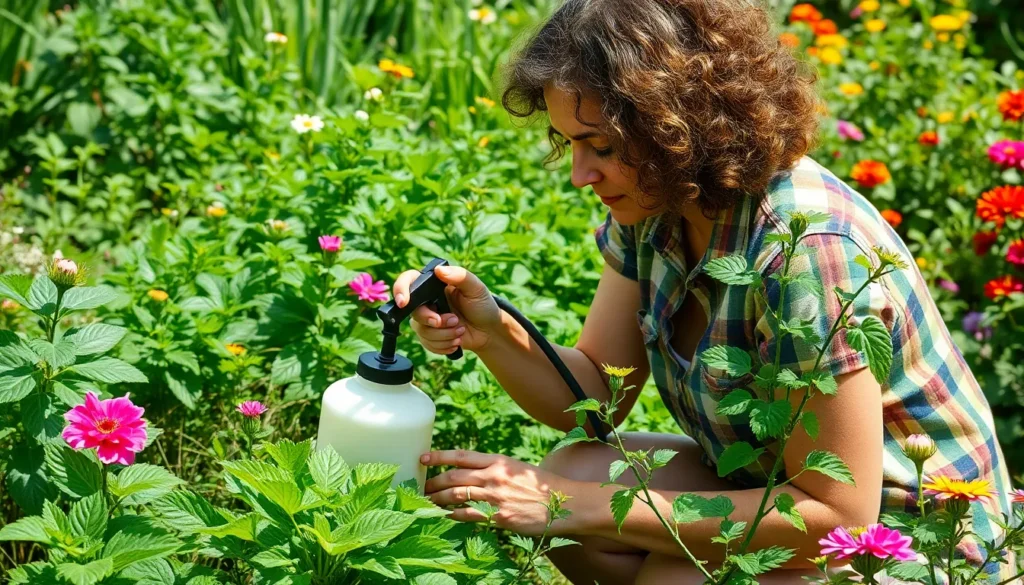We’ve discovered one of nature’s most powerful weapons against garden pests and plant diseases – neem oil. This golden extract from the neem tree has transformed how we protect our plants without relying on harsh chemicals that can harm beneficial insects and soil health.
Plant enthusiasts everywhere are making the switch to this organic solution because it’s incredibly versatile and effective. Whether you’re dealing with aphids on your roses or fungal infections on your tomatoes, neem oil works as both a preventive measure and active treatment. It’s gentle enough for edible crops yet powerful enough to tackle stubborn infestations.
We’re excited to share everything you need to know about using neem oil in your garden. From proper application techniques to understanding when and how often to use it, you’ll learn why this natural pesticide has become our go-to choice for keeping plants healthy and thriving.
What Is Neem Oil and Why Is It Essential for Plant Care
Neem oil represents one of nature’s most powerful plant protection answers, derived from the seeds of the Azadirachta indica tree. This botanical extract has earned recognition among gardeners worldwide for its remarkable ability to safeguard plants while maintaining complete safety for humans, pets, and beneficial insects.
Natural Origin and Extraction Process
Neem trees produce seeds containing concentrated oils that we extract through cold pressing methods. This mechanical extraction process preserves the oil’s natural potency without introducing harmful chemicals or synthetic additives. The resulting amber colored liquid retains all essential compounds that make it so effective against plant threats.
Cold pressing yields approximately 40-50% oil content from each seed, creating a concentrated formula that requires dilution before application. We source the highest quality neem oil from mature trees that are at least 5-7 years old, as these produce seeds with optimal compound concentrations. The extraction process occurs within 24 hours of seed collection to maintain maximum effectiveness.
Active Compounds That Benefit Plants
Azadirachtin serves as neem oil’s primary active ingredient, comprising 0.2-0.6% of the total oil content in quality products. This compound disrupts insect feeding patterns and reproductive cycles without harming beneficial pollinators like bees and butterflies. The substance works by interfering with pest hormone systems, making it impossible for them to molt or reproduce effectively.
Secondary compounds including nimbin, salannin, and gedunin provide additional protective benefits for treated plants. These substances create an inhospitable environment for fungal spores while strengthening plant immune responses against bacterial infections. The oil also contains fatty acids that help improve leaf surface coating and water retention capabilities.
Limonoids present in neem oil offer systemic protection when absorbed through plant tissues. These compounds circulate throughout the plant for up to 22 days after application, providing ongoing defense against new pest invasions. The bitter taste these compounds impart makes treated plants unpalatable to most chewing insects.
Organic Certification and Safety Profile
Certified organic neem oil meets strict USDA standards for pesticide residue levels and processing methods. We recommend products displaying OMRI (Organic Materials Review Institute) certification, which ensures compatibility with organic gardening practices. These certified oils contain no synthetic additives, petroleum based carriers, or artificial preservatives.
Safety testing demonstrates neem oil’s extremely low toxicity rating for mammals, with an LD50 value exceeding 5,000 mg/kg in laboratory studies. This rating places it in the same safety category as common household items like dish soap or table salt. The EPA classifies neem oil as a minimum risk pesticide, requiring no special protective equipment during application.
Food safety protocols allow neem oil application on edible crops up to the day of harvest when properly diluted. We can safely consume vegetables and fruits treated with neem oil after a simple water rinse, making it ideal for kitchen gardens and commercial organic farms. The oil breaks down naturally in sunlight within 3-22 days, leaving no persistent residues in soil or plant tissues.
How Neem Oil Works as a Natural Pesticide for Plants
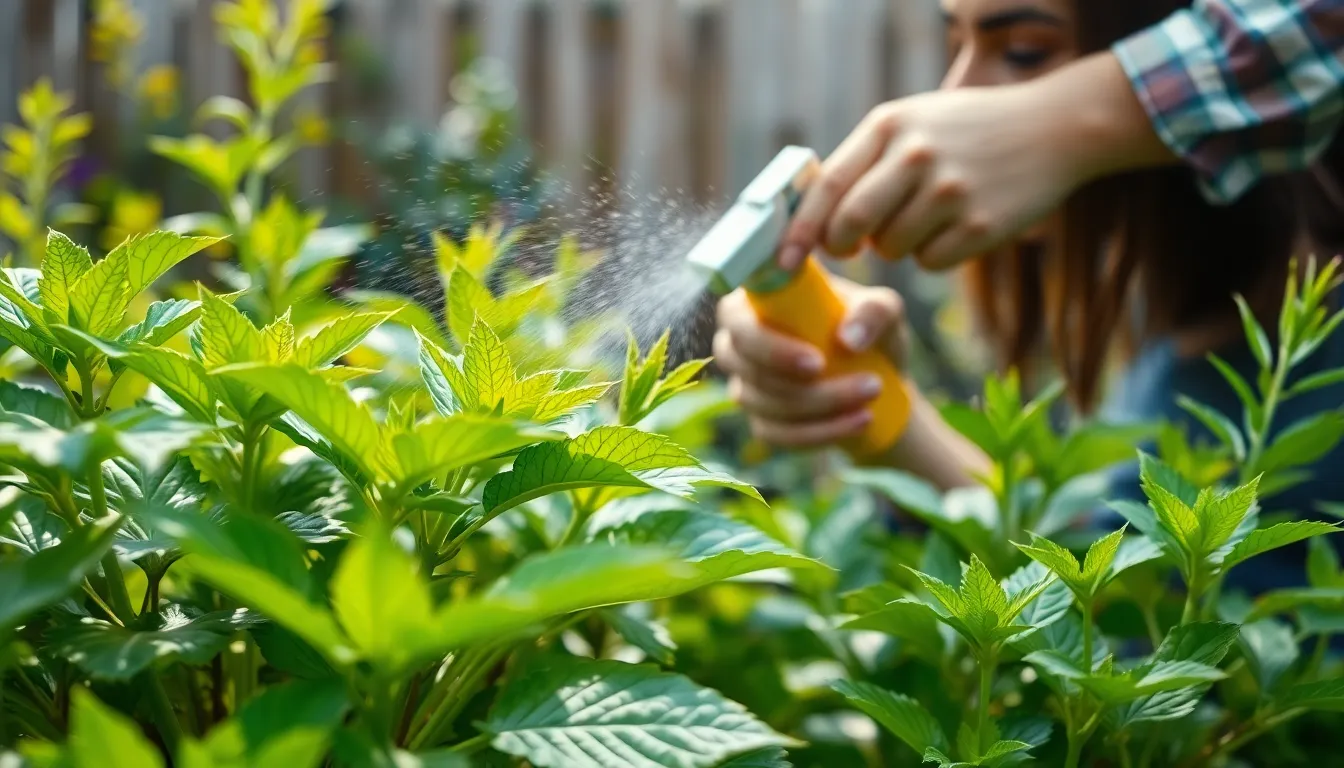
Now that we’ve explored neem oil’s origins and composition, let’s examine the exact mechanisms that make this natural extract so effective against garden pests and diseases.
Disrupting Insect Life Cycles
Neem oil’s primary weapon against garden pests lies in its azadirachtin content, which interferes directly with insect hormone systems. We see this compound disrupting critical life processes including growth, feeding, mating, and reproduction across all developmental stages. Affected insects can’t complete their normal life cycles, leading to important population reductions in our gardens over time.
Beyond hormonal disruption, neem oil creates physical barriers that suffocate harmful insects. The oil coats pest bodies and blocks their breathing pores, killing them through direct contact. This dual action approach ensures we’re targeting both current infestations and preventing future generations from establishing in our plants.
Preventing Fungal and Bacterial Infections
Antifungal properties make neem oil particularly valuable for protecting our plants from common diseases like powdery mildew and black spot. We can apply this natural solution to inhibit fungal growth on both leaves and stems before infections take hold. Regular applications help maintain plant health by preventing initial infections and reducing disease spread throughout our garden spaces.
The oil’s protective qualities extend beyond prevention, actively working to eliminate existing fungal problems. Consistent use creates an environment where harmful fungi struggle to survive and reproduce on our plant surfaces.
Creating a Protective Barrier on Plant Surfaces
When we spray neem oil on our plants, it forms a thin protective coating across foliage and stems. This barrier actively repels insects while preventing fungal spores from settling and establishing infections. The protective layer gives our plants an additional defense system against environmental threats.
Beyond physical protection, neem oil stimulates our plants’ natural defense mechanisms. Enhanced resilience helps plants better withstand environmental stressors and pathogen attacks. We also see improved nutrient uptake and chlorophyll production, which promotes stronger overall plant vigor throughout the growing season.
Top Benefits of Using Neem Oil for Plants
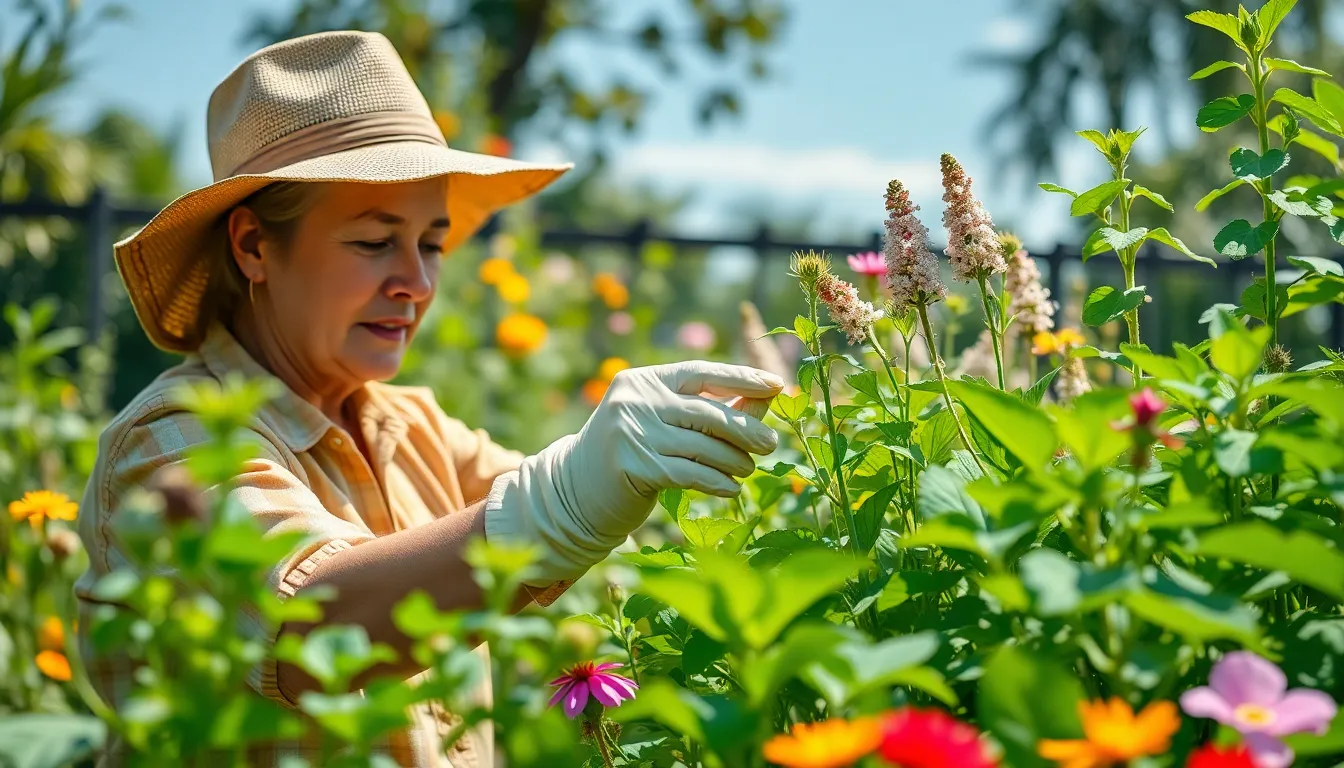
Neem oil delivers remarkable advantages that make it our preferred choice for natural plant protection. These benefits extend far beyond simple pest control, offering comprehensive plant care answers.
Eco-Friendly Alternative to Chemical Pesticides
Eco-conscious gardeners appreciate neem oil’s sustainable approach to pest and disease management. We’ve found that this natural solution breaks down quickly in the environment without accumulating in soil or water systems. Chemical pesticides often leave lasting residues that harm beneficial microorganisms and pollinators, but neem oil biodegrades naturally without causing ecological damage. Garden ecosystems remain balanced when we choose this environmentally responsible option over synthetic alternatives. Soil health improves over time since neem oil doesn’t disrupt beneficial bacteria and fungi that plants need for optimal growth.
Safe for Beneficial Insects and Pollinators
Beneficial insects like bees and ladybugs remain protected when we apply neem oil correctly to our gardens. This selective action specifically targets harmful pests such as aphids, whiteflies, spider mites, caterpillars, thrips, and mealybugs while leaving beneficial species unharmed. Pollinators continue their essential work since neem oil disrupts only the feeding, growth, and reproduction of destructive insects. We’ve observed that garden ecosystems maintain their natural balance because predatory insects aren’t affected by neem oil applications. Native bee populations stay healthy in gardens where we use neem oil as our primary pest control method.
Multi-Purpose Treatment for Various Plant Issues
Versatile neem oil functions effectively as both an insect repellent and fungicide in our gardens. Azadirachtin, the active component, deters insect feeding and growth while other bioactive compounds inhibit fungal spore germination and mycelial growth. Common fungal diseases like powdery mildew, black spot, and rust receive effective treatment through regular neem oil applications. We’ve discovered that while neem oil doesn’t cure already infected plants, it significantly limits disease spread to healthy plant tissue. Plant immunity strengthens when we incorporate neem oil into our regular care routine, creating an unfavorable environment for both pests and pathogens.
Cost-Effective Long-Term Plant Care Solution
Multiple plant care functions make neem oil an economical investment for our gardens and farms. We can apply this versatile solution to herbs, vegetables, fruits, nuts, and ornamental plants with consistent results. Single applications provide pest control, disease prevention, soil health enhancement, and erosion control benefits that would typically require multiple specialized treatments. Long-term savings accumulate since we don’t need separate products for different plant problems. Garden maintenance costs decrease significantly when we rely on neem oil’s comprehensive protection rather than purchasing various chemical treatments throughout the growing season.
Common Plant Pests That Neem Oil Effectively Controls
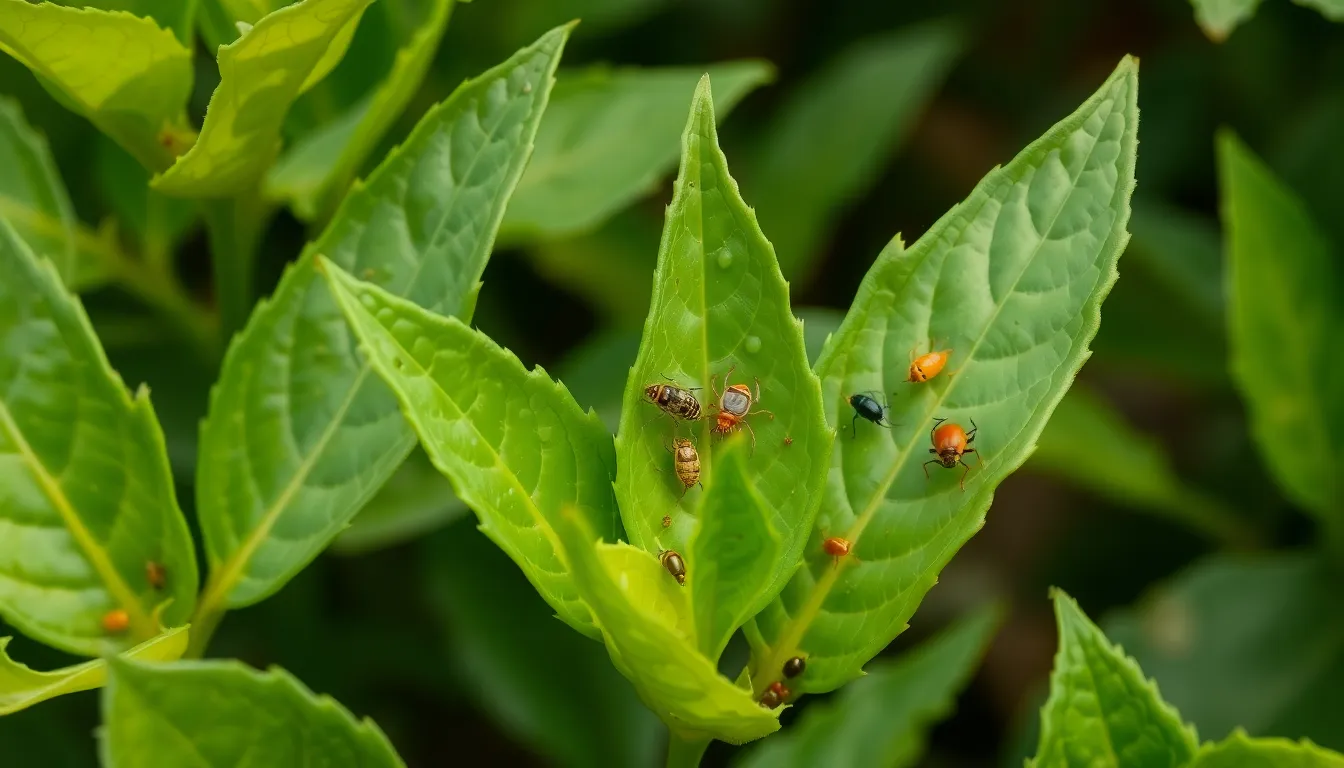
Neem oil targets a wide range of destructive garden pests through its unique biological compounds. Understanding which exact pests respond best to neem oil treatments helps gardeners apply this natural solution more strategically.
Aphids and Scale Insects
Aphids respond rapidly to neem oil applications because these soft-bodied insects absorb the azadirachtin compound directly through their feeding process. We’ve observed that aphid colonies typically show reduced activity within 24-48 hours of treatment, with populations declining significantly over the following week.
Scale insects face similar disruption when exposed to neem oil’s active compounds. These sap-sucking pests become unable to complete their molting cycles, which prevents them from reaching reproductive maturity. The oil’s suffocating properties also coat their protective shells, blocking their breathing pores and eventually leading to elimination.
Spider Mites and Thrips
Spider mites struggle against neem oil’s dual action approach since the treatment both disrupts their reproductive cycles and creates physical barriers on leaf surfaces. These microscopic pests lose their ability to feed effectively when neem oil interferes with their digestive systems.
Thrips larvae in soil environments face particularly challenging conditions when neem oil reaches their developmental stages. We recommend targeting both adult thrips on foliage and their soil-dwelling larvae for comprehensive control. The oil’s persistence in soil provides extended protection against emerging generations.
Whiteflies and Mealybugs
Whiteflies experience immediate feeding disruption when neem oil coats plant surfaces where they typically feed. These flying pests find treated plants less attractive due to the oil’s natural repellent properties, often seeking alternative host plants instead.
Mealybugs face multiple challenges from neem oil applications since their waxy protective coatings become compromised by the oil’s penetrating action. The azadirachtin compound prevents these pests from completing their life cycles while the oil’s physical properties suffocate both adults and nymphs.
Caterpillars and Leaf Miners
Caterpillars consuming neem oil-treated foliage experience severe growth disruptions that prevent normal development into adult moths or butterflies. The oil interferes with their molting hormones, causing larvae to remain in immature stages until they eventually perish.
Leaf miners tunneling through treated plant tissues encounter toxic compounds that disrupt their feeding patterns and development. These pests create characteristic trails in leaves, but neem oil applications reduce their ability to complete these tunnels and emerge as adults, breaking their reproductive cycle effectively.
Plant Diseases Neem Oil Can Prevent and Treat
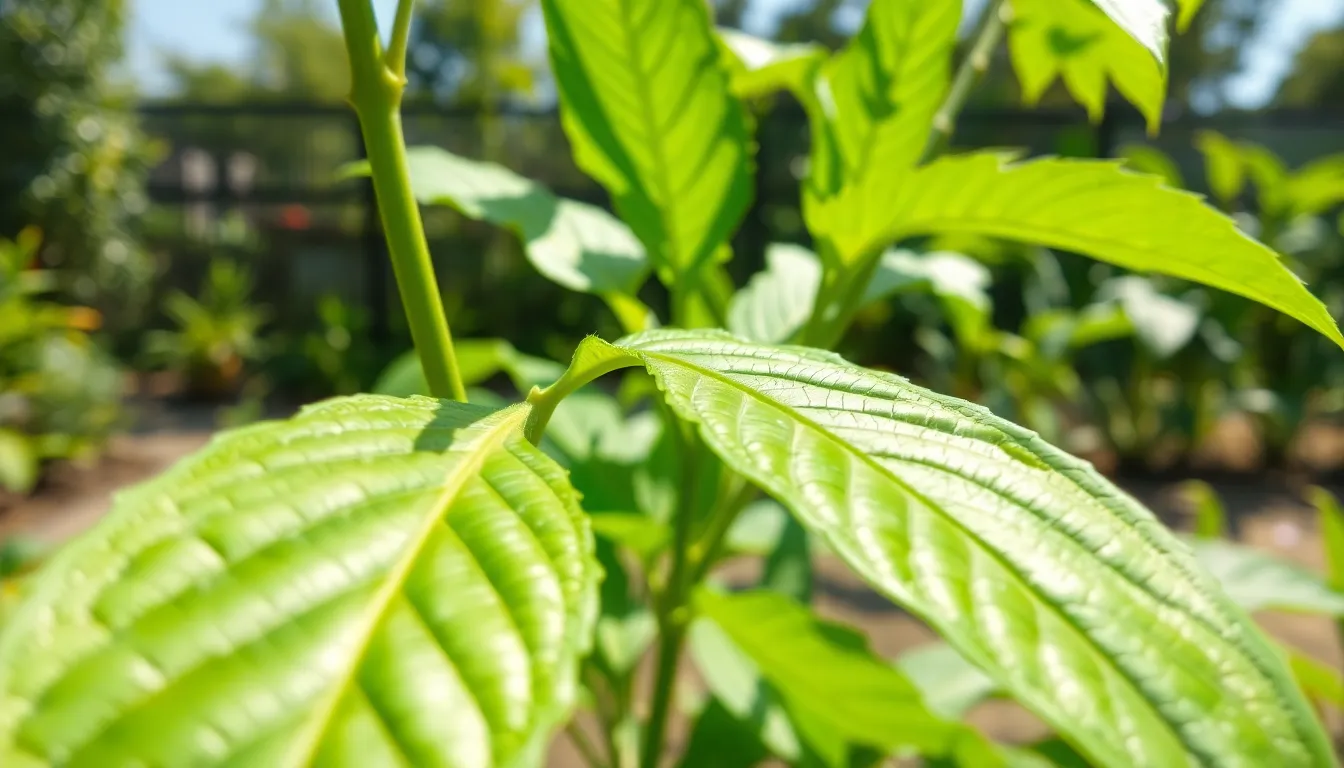
Beyond pest control, neem oil serves as a powerful defense against fungal and bacterial diseases that threaten plant health. We’ll explore the exact diseases neem oil can effectively prevent and treat.
Powdery Mildew and Black Spot
Powdery mildew and black spot respond exceptionally well to neem oil’s antifungal properties. These common diseases affect leaves and stems, creating white powdery patches or dark spots that weaken plants over time.
Neem oil disrupts the growth and reproduction of powdery mildew fungi by interfering with their cellular processes. Regular applications reduce fungal spores and protect new growth from infection. Black spot pathogens face similar disruption when we apply neem oil treatments consistently.
We recommend spraying affected plants every 7-14 days during disease-prone periods for optimal control. The oil creates a protective barrier on leaf surfaces, preventing spores from establishing new infections.
Rust and Leaf Spot Diseases
Rust diseases create orange or brown pustules on leaves, while leaf spot diseases cause circular brown or black spots that eventually lead to leaf drop. Neem oil manages both conditions by inhibiting fungal development on leaf surfaces.
The oil’s antifungal compounds prevent fungal infections from taking hold and spreading throughout the plant. Early treatment proves most effective, as neem oil can halt disease progression before extensive damage occurs.
Thorough coverage of both upper and lower leaf surfaces ensures maximum protection against these fungal pathogens. We’ve found that combining neem oil treatments with proper air circulation significantly improves disease control outcomes.
Root Rot and Damping-Off
Root rot and damping-off diseases pose serious threats to seedlings and young plants, often causing wilting and death. These soil-borne fungi attack plant roots and stems at soil level, making prevention crucial for plant survival.
We can use neem oil as a soil drench or seed treatment to reduce fungal spores in the soil and protect vulnerable root systems. The oil’s fungicidal properties create an unfavorable environment for pathogen development around plant roots.
Preventive practices enhance neem oil’s effectiveness against these diseases. Proper seed spacing allows for better air circulation, while watering from below prevents moisture accumulation on plant surfaces. Using pots with adequate drainage holes prevents waterlogged conditions that encourage fungal growth.
Neem oil treatments have proven effective on seedlings to halt damping-off disease progression. Early intervention with neem oil applications can save affected plants and prevent disease spread to healthy specimens.
Bacterial Blight and Canker
Bacterial blight and canker diseases cause wilting, brown spots, and stem lesions that can kill entire branches or plants. These bacterial infections often enter through wounds or natural openings in plant tissues.
Neem oil’s antibacterial properties help suppress these infections by disrupting bacterial cell membranes and limiting pathogen invasion. The oil interferes with bacterial reproduction and spread, reducing disease severity over time.
We apply neem oil treatments to affected areas and surrounding healthy tissue to prevent bacterial spread. Consistent applications during warm, humid conditions when bacterial diseases thrive provide the best protection.
Combining neem oil treatments with proper sanitation practices, such as removing infected plant material and sterilizing tools, maximizes disease control effectiveness. This integrated approach helps prevent bacterial pathogens from establishing persistent infections in our gardens.
How to Properly Apply Neem Oil for Plants
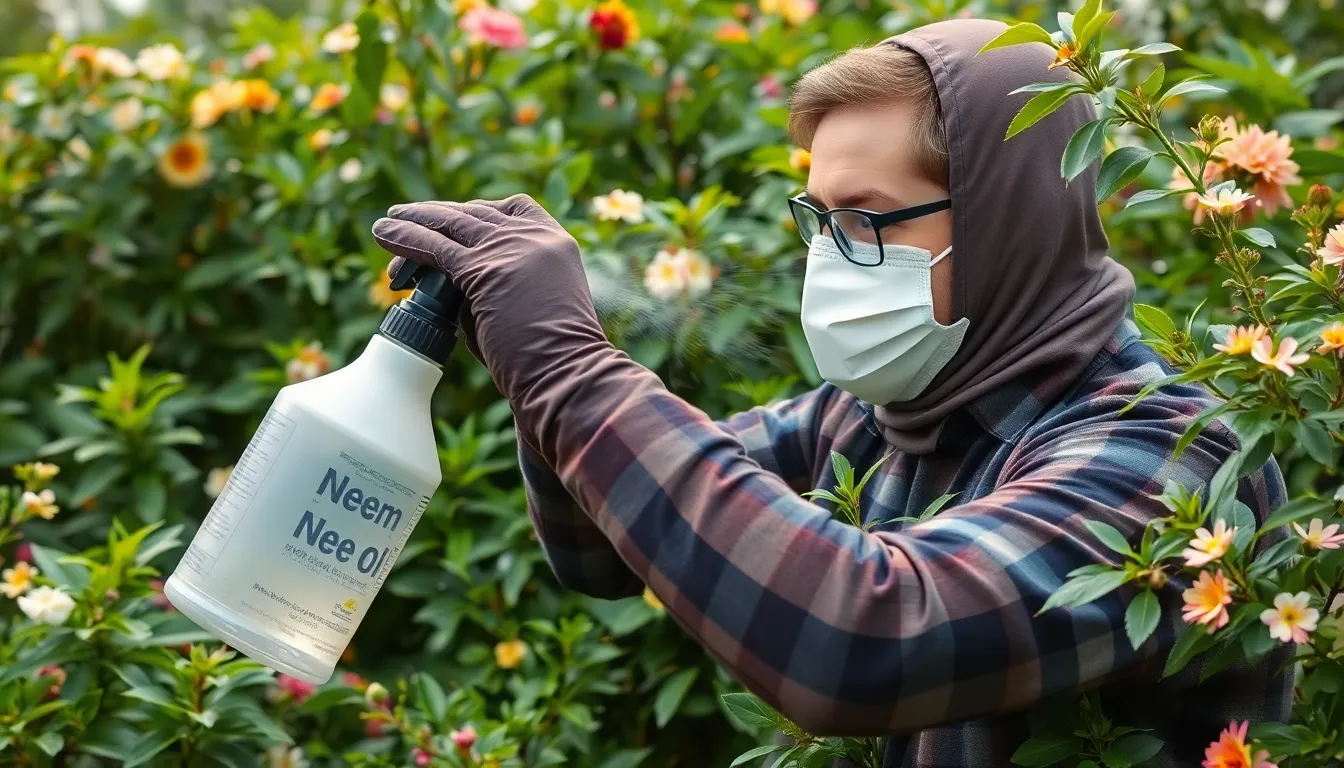
Getting the most from neem oil requires proper preparation and application techniques. We’ll guide you through the essential steps to ensure safe and effective treatment of your plants.
Mixing Ratios and Dilution Guidelines
Create the perfect neem oil solution by diluting concentrate products correctly. Start with 1 to 2 tablespoons of neem oil per gallon of water for most garden applications. Add 1 to 2 teaspoons of mild dish detergent or horticultural soap per gallon as an emulsifier to help the oil and water mix effectively.
Avoid using more neem oil than recommended ratios suggest. Excess concentration can cause leaf burn, especially when plants are exposed to direct sunlight. Test your diluted solution on a small section of leaves before treating the entire plant to check for sensitivity reactions.
Always mix fresh answers for each application session. Neem oil answers don’t store well once diluted and lose effectiveness over time.
Best Application Methods and Equipment
Use a pump sprayer for foliar applications to achieve even coverage across all plant surfaces. Cover the entire plant thoroughly, including the undersides of leaves where many pests like to hide. Spray until the solution begins to drip from leaf surfaces.
Apply neem oil as a soil drench for targeting root zone pests and soil-borne diseases. Pour the diluted solution directly onto the soil around the plant base, allowing it to penetrate the root zone. This method works particularly well for controlling fungus gnats and other soil-dwelling insects.
Wear protective gloves and masks during application to avoid skin and respiratory irritation. Clean your equipment thoroughly after each use to prevent clogging and ensure optimal performance for future treatments.
Timing and Frequency Recommendations
Apply neem oil every 7 to 14 days as a preventative measure or to control existing infestations. Regular applications maintain consistent protection against pests and diseases throughout the growing season. Monitor your plants closely and adjust frequency based on pest pressure and plant response.
Spray dormant plants before bud break to eliminate overwintering pests and their eggs. This timing helps reduce pest populations before they become active in spring. During the growing season, use treatments as needed but avoid excessive frequency to prevent plant stress.
Limit applications to no more than once per week on sensitive plants. Fruit trees and delicate flowering plants may require less frequent treatments to avoid potential damage.
Weather Considerations for Optimal Results
Choose dry, windless days for neem oil applications to prevent drift and ensure proper coverage. Wind can carry the spray away from target areas and reduce treatment effectiveness. Calm conditions allow for precise application and better adherence to plant surfaces.
Avoid spraying when temperatures drop below 40°F or when frost is expected. Cold temperatures reduce neem oil’s effectiveness and can stress plants further. Wait for milder weather conditions before treating your garden.
Apply treatments in early morning or late afternoon to prevent leaf burn from harsh sunlight. Direct sunlight combined with oil residue can damage plant tissues. Allow leaves to dry naturally after spraying without rinsing off the treatment immediately.
Safety Precautions When Using Neem Oil for Plants
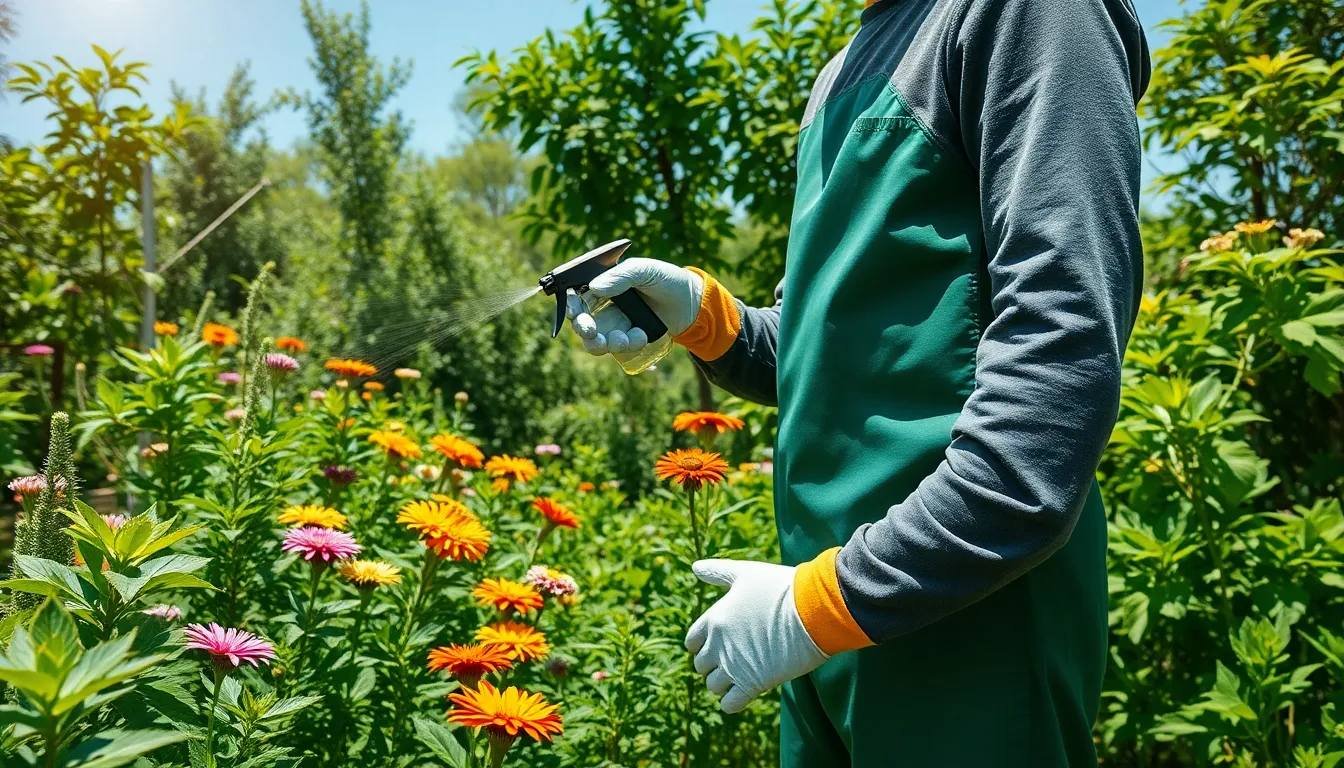
While neem oil offers excellent pest and disease control benefits, we must follow proper safety guidelines to protect ourselves, our pets, and our plants during application.
Personal Protective Equipment Guidelines
Protective clothing prevents direct contact with neem oil, which can cause mild skin and eye irritation. We recommend wearing gloves and long sleeves during every application to minimize exposure risks. Avoid inhaling the oil during mixing and spraying, as respiratory irritation may occur with prolonged exposure.
Hand washing becomes essential after handling neem oil products, even when wearing protective equipment. We should thoroughly wash our hands with soap and warm water before eating, drinking, or touching our face. Never ingest neem oil or allow it to come into contact with open wounds or sensitive skin areas.
Pet and Wildlife Safety Measures
Dogs and cats remain safe around neem oil applications when we use the product correctly, as it’s organic and breaks down quickly in the environment. We must keep pets away from treated areas until the neem oil has completely dried on plant surfaces. This drying period typically takes 2-4 hours depending on weather conditions.
Aquatic life faces serious risks from neem oil exposure, making it toxic to fish and other water dwelling creatures. We should never apply neem oil near ponds, streams, or other water bodies where runoff could harm aquatic wildlife. Maintain at least a 25 foot buffer zone from any water source during application.
Storage and Handling Best Practices
Cool, dark storage locations preserve neem oil’s active ingredients, especially azadirachtin, which degrades rapidly when exposed to heat and light. We should store unopened containers in temperatures below 70°F and away from direct sunlight to maintain maximum potency. Properly stored neem oil maintains its effectiveness for up to two years when unopened.
Six month usage windows apply to opened neem oil containers for optimal effectiveness in pest and disease control. We need to shake the solution frequently during application since neem oil naturally separates from water over time. Always dilute neem oil with warm water and add mild soap as an emulsifier before application.
Avoiding Phytotoxicity and Plant Damage
Spot testing prevents widespread damage by revealing how individual plants respond to neem oil applications. We should apply the solution to a small leaf area and wait 24 hours to check for adverse reactions before treating the entire plant. This precaution becomes especially important when treating new plant varieties or sensitive species.
Temperature timing affects application success since neem oil can cause foliage burn when applied during harsh sunlight or temperatures above 85°F. We achieve best results by applying neem oil during early morning or late evening hours when temperatures remain moderate. Avoid applications on windy days when spray drift could affect unintended plants.
Plant stress conditions require careful consideration before neem oil application, as stressed plants show increased sensitivity to treatments. We should avoid treating plants suffering from overwatering, underwatering, or recent transplant shock until they recover. New seedlings and recently transplanted plants need extra time to establish before receiving neem oil treatments.
Concentration levels must stay within safe ranges to prevent plant damage, with 0.5% answers providing effective pest control for most applications. We should never exceed 1.1% concentration, as higher levels may harm even healthy, established plants. Always follow label directions and measure carefully when mixing answers.
Best Neem Oil Products for Different Plant Types
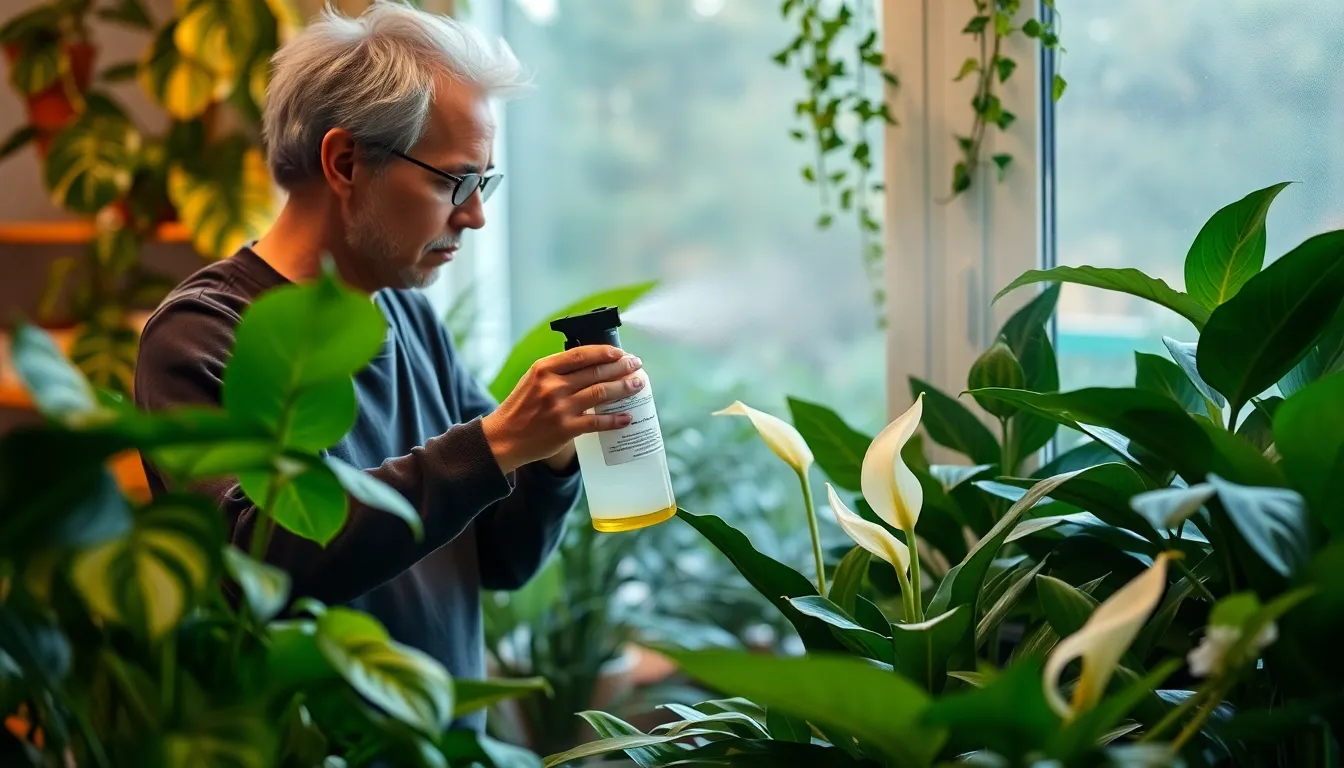
Different plants require customized neem oil applications to maximize their health benefits and pest control effectiveness.
Indoor Houseplants and Container Gardens
Diluted neem oil sprays work exceptionally well for indoor plants when mixed at 1-2 teaspoons per gallon of water. We recommend applying this solution to both leaf surfaces and stems using a fine mist sprayer for even coverage. Indoor environments create ideal conditions for spider mites, aphids, and whiteflies to thrive, making regular neem oil treatments essential for plant health.
Foliar applications every 7-14 days prevent common fungal diseases like powdery mildew that flourish in humid indoor conditions. Container plants benefit from neem oil’s systemic protection, which circulates through plant tissues for up to 22 days. We’ve found that houseplants like pothos, rubber trees, and peace lilies respond particularly well to gentle neem oil treatments.
Soil drenching with diluted neem oil eliminates root zone pests without harming beneficial soil microorganisms. Indoor gardeners can safely use neem oil year-round since it doesn’t leave harmful residues on plant surfaces.
Outdoor Vegetable Gardens and Herbs
Weekly neem oil applications protect edible crops from aphids, caterpillars, and other common garden pests throughout the growing season. We apply neem oil at 1-2 tablespoons per gallon of water during early morning or evening hours to prevent leaf burn. Vegetables like tomatoes, peppers, and cucumbers show remarkable pest resistance when treated regularly with neem oil.
Herbs such as basil, oregano, and mint thrive under neem oil protection without affecting their flavor profiles or culinary quality. Pre-harvest intervals aren’t necessary with neem oil since it’s approved for organic food production. We recommend combining foliar sprays with soil drenches to create comprehensive pest management systems.
Root zone applications improve soil health while protecting plants from underground pests like root aphids and fungus gnats. Neem oil breaks down naturally in soil, supporting beneficial bacteria and mycorrhizal fungi that enhance nutrient uptake.
Ornamental Plants and Flowering Shrubs
Ornamental plants benefit from specialized neem oil formulations designed for decorative landscaping applications. We use wettable powder or emulsifiable concentrate products that provide longer-lasting protection for roses, azaleas, and flowering shrubs. These formulations interrupt pest life cycles more effectively than basic oil answers.
Flowering plants maintain their aesthetic appeal when neem oil prevents damage from scale insects, thrips, and leaf miners. Regular applications during the growing season keep ornamental gardens looking vibrant and healthy. We’ve observed that neem oil treatments actually enhance flower production by reducing plant stress from pest damage.
Disease prevention becomes crucial for ornamental value, and neem oil’s antifungal properties protect against black spot, rust, and blight infections. Shrubs treated with neem oil show improved overall vigor and resistance to environmental stressors.
Fruit Trees and Large Industry Plants
Large-scale applications require concentrated neem oil products that can be mixed in higher volumes for efficient coverage of mature trees and extensive plantings. We recommend using backpack sprayers or hose-end applicators to reach all plant surfaces effectively. Fruit trees like apple, citrus, and stone fruits respond well to integrated pest management programs featuring neem oil.
Soil drenching around tree root zones provides systemic protection against boring insects and root pests that can damage large plants. Application rates of 2-4 tablespoons per gallon work best for established trees and industry plants. We apply neem oil during dormant seasons and throughout active growing periods for comprehensive protection.
Orchard management becomes more sustainable with neem oil treatments that support beneficial insect populations while controlling harmful pests. Large industry plants benefit from neem oil’s ability to reduce pest populations without environmental impact, making it ideal for public spaces and commercial properties.
Timing Your Neem Oil Applications for Maximum Effectiveness
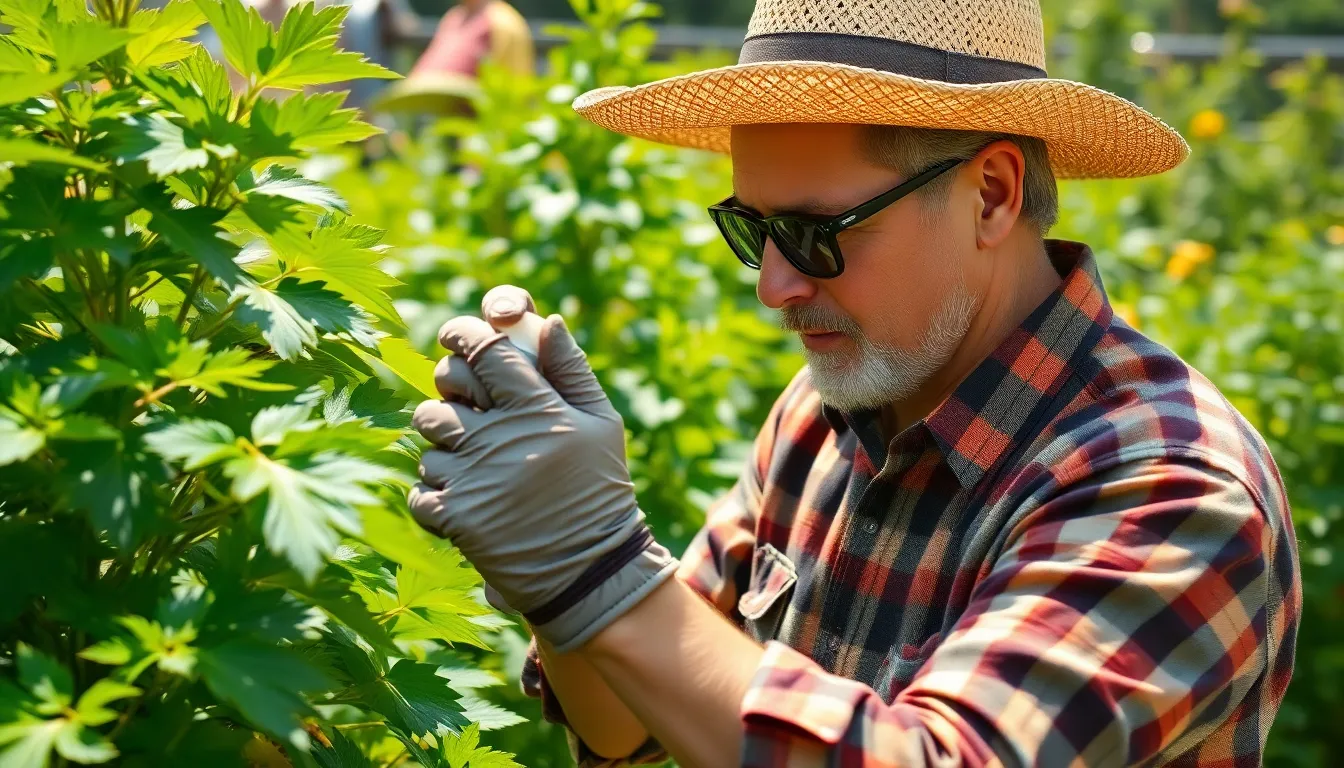
Perfect timing transforms neem oil from a simple garden spray into a powerful plant protection system. Strategic application schedules maximize azadirachtin’s effectiveness while disrupting pest life cycles at their most vulnerable stages.
Seasonal Application Schedules
Spring applications should begin before pests appear in your garden. We recommend starting neem oil treatments 2-3 weeks before the typical emergence of common pests like aphids and spider mites. Early season sprays create a protective barrier that repels insects and prevents egg laying on plant surfaces.
Summer maintenance requires consistent 7-14 day application intervals during peak pest activity. Hot weather accelerates pest reproduction cycles, making regular neem oil applications essential for maintaining control. Weekly treatments during July and August provide optimal protection against thrips, whiteflies, and scale insects.
Fall prevention strategies focus on disrupting overwintering pest populations. Late season applications target pests preparing for dormancy and prevent spring reinfestation. October and November treatments reduce pest eggs and larvae that survive winter in soil and plant debris.
Winter dormancy periods offer opportunities for soil drenching applications. Root zone treatments during plant dormancy protect against soil dwelling pests without risking leaf burn. Cold pressed neem oil maintains its effectiveness even in cooler temperatures between 35-50°F.
Pre-Infestation Prevention Strategies
Baseline protection starts with thorough coverage of both leaf surfaces before any pest signs appear. Spray neem oil on the undersides of leaves where pests typically begin feeding and laying eggs. Complete coverage ensures azadirachtin reaches all potential pest entry points.
Cultural integration combines neem oil applications with proper sanitation practices. Remove plant debris and weeds that harbor overwintering pests before applying preventive neem oil treatments. Clean garden tools and containers with diluted neem oil solution to prevent pest transfer.
Companion planting enhances neem oil’s repellent properties when combined with pest deterrent plants. Marigolds, basil, and catnip naturally repel insects while neem oil applications provide additional protection. This integrated approach reduces overall pest pressure in your garden.
Soil preparation includes neem oil drenching before planting to eliminate root zone pests. Mix 2 tablespoons of neem oil per gallon of water and saturate the soil around planting areas. This creates a pest free environment that supports healthy plant establishment.
Treatment During Active Pest Outbreaks
Immediate response requires daily neem oil applications for the first 3-5 days of severe infestations. Azadirachtin suffocates soft bodied insects like aphids within 24-48 hours of direct contact. Heavy infestations may require morning and evening treatments to achieve rapid population reduction.
Targeted application focuses on pest aggregation sites where insects cluster for feeding and reproduction. Spider mites concentrate on leaf undersides while scale insects attach to stems and branches. Direct spray application to these areas maximizes neem oil contact with pests.
Life cycle disruption timing aligns treatments with pest reproduction cycles for maximum effectiveness. Aphids reproduce every 7-10 days, requiring applications that interrupt each generation. Thrips complete development in 14-21 days, making bi weekly treatments essential for population control.
Resistance management alternates neem oil with other organic treatments to prevent pest adaptation. Insecticidal soap applications between neem oil treatments maintain pest pressure while reducing the risk of resistance development. This rotation strategy preserves neem oil’s long term effectiveness.
Post-Treatment Monitoring and Maintenance
Weekly inspections identify new pest activity before populations rebuild to damaging levels. Check leaf undersides, stem joints, and growing tips where pests typically reestablish after treatment. Early detection allows for prompt retreatment before pest populations explode.
Residue management accounts for neem oil’s natural degradation in sunlight and rain. Reapply neem oil every 7-14 days or after important rainfall that washes away protective residues. UV exposure breaks down azadirachtin within 3-5 days, requiring consistent reapplication schedules.
Population tracking documents pest reduction rates to optimize future treatment timing. Record pest numbers before and after each neem oil application to identify the most effective treatment intervals. This data helps refine your garden’s exact pest management schedule.
Beneficial insect protection schedules neem oil applications to minimize impact on pollinators and predatory insects. Apply treatments during early morning or late evening when beneficial insects are less active. Monitor for beneficial insect recovery between applications to ensure network balance.
Combining Neem Oil with Other Natural Plant Care Methods
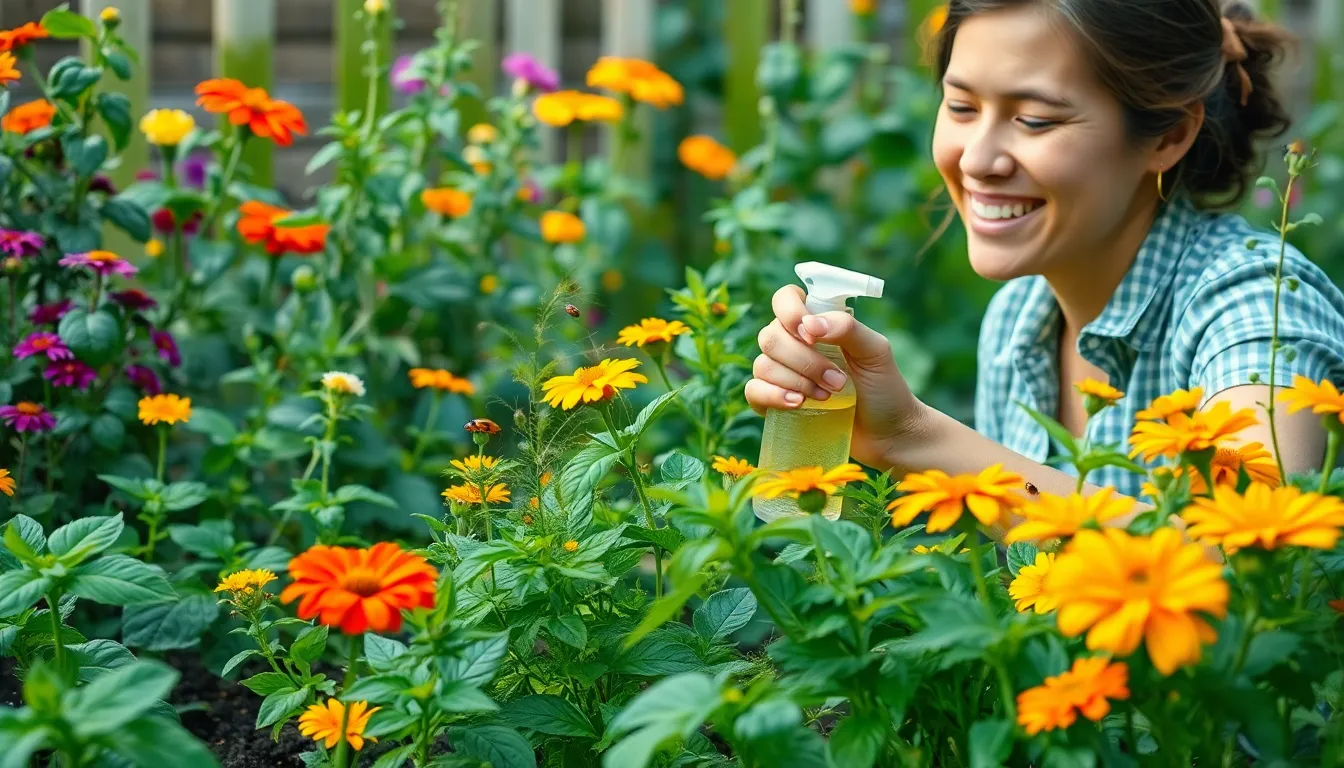
We can maximize neem oil’s effectiveness by integrating it with complementary natural plant care strategies that work synergistically to create robust plant defense systems.
Companion Planting Strategies
Companion planting enhances neem oil’s pest control capabilities by creating natural barriers that deter insects before they reach vulnerable plants. We recommend planting herbs like basil or marigold near crops that frequently attract pests, as these companion plants naturally repel many common garden insects. Neem oil applications then target any residual pests that bypass these natural deterrents, providing a comprehensive multi-layered defense system.
Strategic plant placement amplifies protection when we combine aromatic herbs with regular neem oil treatments. Plants such as rosemary, thyme, and mint release compounds that confuse pest navigation systems, while neem oil disrupts the life cycles of insects that manage to locate target plants. This dual approach significantly reduces pest pressure compared to using either method alone.
Trap cropping works exceptionally well with neem oil applications to manage pest populations effectively. We plant attractive crops like nasturtiums or radishes to lure pests away from main crops, then apply neem oil to both trap crops and primary plants to eliminate concentrated pest populations and prevent migration.
Beneficial Insect Integration
Neem oil’s selective action preserves beneficial insects when we apply it correctly, allowing natural predators to continue controlling pest populations. We time applications to avoid peak pollinator activity periods, typically early morning or late evening, ensuring that ladybugs, lacewings, and parasitic wasps can continue their pest management work.
Beneficial insects provide biological control that complements neem oil’s direct pest suppression effects. We encourage populations of predatory insects by maintaining habitat diversity while using neem oil to reduce pest numbers to manageable levels. This balance prevents beneficial insects from being overwhelmed by pest populations while maintaining their natural hunting effectiveness.
Integration requires careful timing to maximize both neem oil effectiveness and beneficial insect activity. We apply neem oil treatments when beneficial insects are less active, allowing the oil to target harmful pests without disrupting natural predator-prey relationships that keep gardens healthy long term.
Organic Fertilizer and Soil Amendment Pairings
Neem cake enhances soil quality while providing additional pest control benefits beyond what neem oil applications achieve above ground. We incorporate neem cake as a soil amendment to suppress soil-borne pests and diseases while acting as a natural fertilizer that improves soil fertility and crop yield.
Organic compounds in neem material improve soil conditions when we pair them with other organic fertilizers to boost nutrient availability. We combine neem cake with compost or aged manure to create nutrient-rich growing mediums that promote plant health while deterring root zone pests and diseases.
Soil health improvements support plant resilience against the pests and diseases that neem oil treatments target above ground. We use neem-based soil amendments to strengthen plant root systems and improve nutrient uptake, creating healthier plants that better resist pest damage and recover more quickly from infestations.
Integrated Pest Management Approaches
IPM frameworks benefit significantly from neem oil’s environmentally friendly pest control capabilities without requiring synthetic chemical inputs. We combine neem oil applications with cultural controls like crop rotation and sanitation, mechanical controls such as traps and barriers, and biological controls including beneficial insects to create comprehensive pest management systems.
Monitoring programs guide neem oil applications within broader IPM strategies to prevent pest resistance development. We track pest populations and damage levels to determine optimal application timing and frequency, ensuring that neem oil treatments remain effective while supporting other control methods.
Sustainable pest reduction occurs when we integrate neem oil with multiple IPM components rather than relying on single control methods. We use neem oil to reduce pest populations to levels where natural predators and cultural practices can maintain control, creating long-term sustainable pest management that protects both plants and beneficial garden ecosystems.
Conclusion
We’ve covered everything you need to know about using neem oil as a natural and effective solution for your garden’s health. From understanding its powerful compounds to mastering proper application techniques neem oil offers an eco-friendly alternative that protects your plants without compromising safety.
The versatility of neem oil makes it an invaluable addition to any gardener’s toolkit. Whether you’re dealing with persistent aphids on your roses or preventing fungal diseases on your vegetables neem oil delivers consistent results while supporting beneficial insects.
By incorporating neem oil into your regular plant care routine you’re choosing a sustainable approach that benefits both your garden and the environment. Start with small applications test your plants’ responses and gradually build a comprehensive treatment schedule that keeps your garden thriving naturally.
Frequently Asked Questions
What is neem oil and where does it come from?
Neem oil is a natural extract derived from the seeds of the Azadirachta indica tree through a cold pressing process. This organic oil contains active compounds like azadirachtin that effectively protect plants from pests and diseases. The extraction method preserves the oil’s natural potency, making it a safe and effective solution for both home gardens and commercial organic farms.
How does neem oil work against garden pests?
Neem oil works through multiple mechanisms to control pests. The azadirachtin compound disrupts insect hormone systems, affecting their growth, feeding, mating, and reproduction. It also creates physical barriers that suffocate harmful insects by coating their bodies and blocking breathing pores. This dual action leads to significant pest population reductions over time.
Is neem oil safe for edible crops and beneficial insects?
Yes, neem oil is completely safe for edible crops and won’t harm beneficial insects like pollinators. It selectively targets harmful pests while leaving beneficial insects unharmed, preserving garden ecosystems. The oil is organic certified, has low toxicity, and breaks down naturally without leaving harmful residues on plants or in soil.
What pests can neem oil effectively control?
Neem oil effectively controls various garden pests including aphids, scale insects, spider mites, thrips, whiteflies, mealybugs, caterpillars, and leaf miners. It disrupts their life cycles through unique biological compounds, with many pests showing decreased activity within 24-48 hours of treatment. The oil targets both adult pests and their larvae for comprehensive control.
Can neem oil prevent and treat plant diseases?
Yes, neem oil has powerful antifungal properties that prevent and treat various plant diseases including powdery mildew, black spot, rust, leaf spot diseases, root rot, and bacterial blight. It creates a protective barrier on plant surfaces and disrupts pathogen growth and reproduction. Regular applications are recommended during disease-prone periods for optimal control.
How do I properly mix and apply neem oil?
Mix 1 to 2 tablespoons of neem oil per gallon of water with a mild dish detergent as an emulsifier. Always test the solution on a small leaf area first to avoid leaf burn. Apply using a pump sprayer for foliar applications or as a soil drench for root zone pests. Apply every 7 to 14 days on dry, windless days during moderate temperatures.
What safety precautions should I take when using neem oil?
Wear personal protective equipment to prevent skin and eye irritation. Keep pets away from treated areas until the oil has dried. Avoid applying near water bodies due to toxicity to aquatic life. Store neem oil in cool, dark places and use within specified time frames. Always spot test to avoid phytotoxicity and apply during moderate temperatures.
When is the best time to apply neem oil?
Start treatments in spring before pests emerge, maintain consistent applications during summer, and target overwintering pests in fall. Apply soil drenches during winter dormancy for root zone protection. For active infestations, apply daily until controlled. Always apply during moderate temperatures on dry, windless days for maximum effectiveness.
How long does neem oil protection last on plants?
Neem oil provides systemic protection that circulates through plant tissues for up to 22 days. However, for optimal results, reapply every 7 to 14 days depending on pest pressure and environmental conditions. The oil forms a protective barrier on plant surfaces that repels insects and inhibits fungal spores throughout the growing season.
Can I use neem oil with other natural pest control methods?
Yes, neem oil works excellently as part of an Integrated Pest Management (IPM) approach. It complements companion planting with herbs like basil and marigold, beneficial insect programs, and cultural practices like proper sanitation. You can also use neem cake as a soil amendment alongside neem oil applications for comprehensive plant protection.

